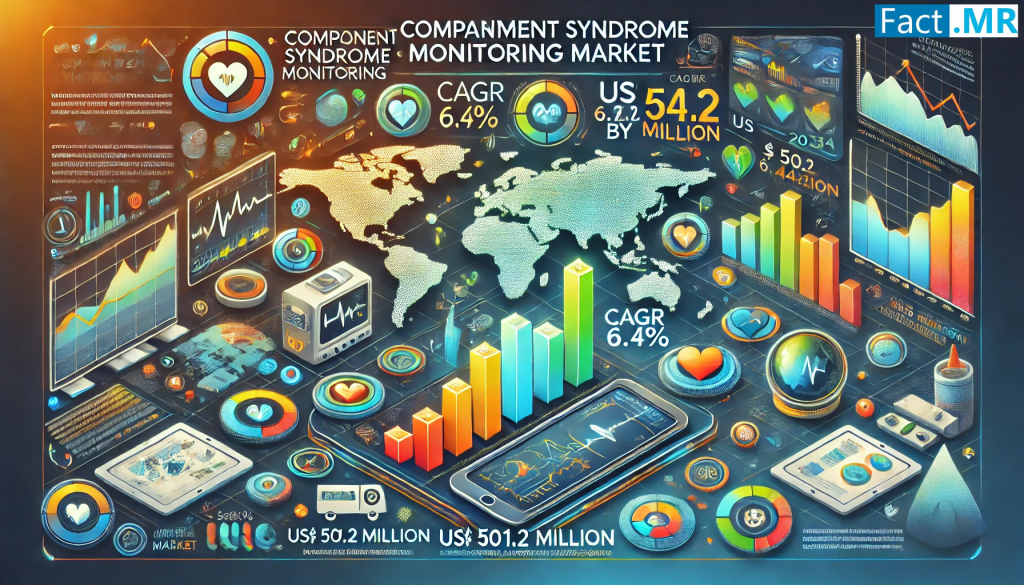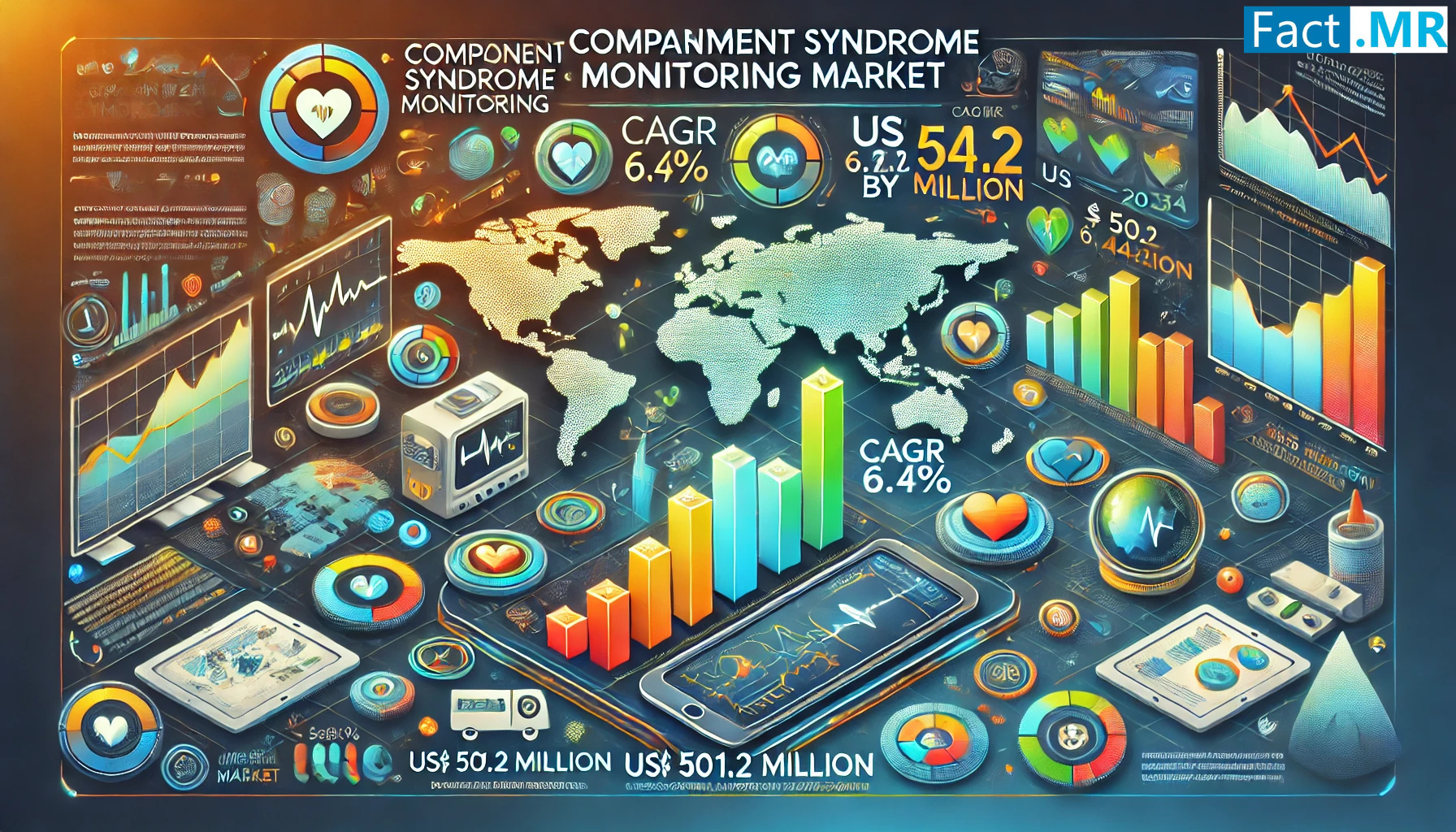
Rockville, MD, Dec. 17, 2024 (GLOBE NEWSWIRE) — Fact.MR, a market research and competitive intelligence provider, states that the compartment syndrome monitoring market is estimated at US$ 270.5 million in 2024 and is forecasted to reach US$ 501.2 million by the end of 2034.
Compartment syndrome monitoring is a dynamic segment within the broader medical monitoring device industry, characterized by the continuous evolution of technologies aimed at early detection and effective management of compartment syndrome. Compartment syndrome, a condition marked by high pressure within muscular compartments, necessitates vigilant monitoring to prevent severe complications.
Ongoing advancements in monitoring technologies are a key market trend. Integration of wireless connectivity, real-time data analysis, and improved sensor technologies are enhancing the precision and responsiveness of compartment syndrome monitoring devices. Rise of remote patient monitoring is also a notable trend in the compartment syndrome monitoring market. The ability to monitor compartment pressures remotely, especially in emergency scenarios, aligns with the broader shift toward telehealth and facilitates timely interventions.
Increasing number of trauma cases and sports-related injuries globally are further driving the need for advanced compartment syndrome monitoring technologies, as compartment syndrome often develops in the aftermath of such incidents. Growing awareness among healthcare professionals about the importance of early diagnosis and monitoring of compartment syndrome is boosting the adoption of advanced patient monitoring devices.
For More Insights into the Market, Request a Sample of this Report: https://www.factmr.com/connectus/sample?flag=S&rep_id=9859
 Key Takeaways from Market Study
Key Takeaways from Market Study
- Global demand for compartment syndrome monitoring systems is forecasted to rise at a CAGR of 6.4% from 2024 to 2034.
- The United States market is estimated at US$ 81 million in 2024.
- Germany’s robust healthcare system, aging population, sports culture, and a strong focus on research and development position it as a key marketplace for compartment syndrome monitoring device suppliers.
- The market in Japan is forecasted to reach US$ 28 million by 2034-end.
“Modern compartment syndrome monitoring systems are aiding in early detection and leading to effective intervention and improved patient outcomes, thus driving market growth,” says a Fact.MR analyst.
Leading Players Driving Innovation in the Compartment Syndrome Monitoring Market:
Biometrix Corporation, Spiegelberg GmbH & Co. KG, Dickenson and Company, MY01, Inc., Millar, Inc., Medline Industries, Inc., Becton, Potrero Medical, ConvaTec Group, Critical Care Diagnostics (C2Dx), Inc.
Competitive Landscape
Strategies employed by key players in the compartment syndrome monitoring market to earn high profits include product innovations, diversification, global market expansion, customer-centric approaches, and strategic partnerships.
Market leaders are focused on allocating substantial resources to research and development activities to enhance existing technologies or develop innovative solutions. Continuous innovation is helping companies to stay ahead of the competition and attract a wider customer base.
Get Customization on this Report for Specific Research Solutions- https://www.factmr.com/connectus/sample?flag=S&rep_id=9859
More Valuable Insights on Offer
Fact.MR, in its new offering, presents an unbiased analysis of the global compartment syndrome monitoring market, presenting historical demand data for 2018 to 2023 and forecast statistics for 2024 to 2034.
The study divulges essential insights on the market based on device (intra-compartmental pressure monitoring systems, intramuscular tissue pressure measuring [IMP] catheters, disposables/accessories), indication (acute compartment syndrome, chronic compartment syndrome, abdominal compartment syndrome), anatomy (upper extremities, lower extremities, abdomen), and end user (hospitals, ambulatory surgical centers, orthopedic office-based clinics), across six major regions of the world (North America, Latin America, Europe, East Asia, South Asia & Oceania, and MEA).
Explore More Related Studies Published by Fact.MR Research:
Neonatal Monitoring Equipment Market Forecast, Trend Analysis & Competition Tracking – Global Market insights 2018 to 2028
The global heart failure monitoring systems market was valued at US$ 13,379.4 million in 2023 and has been forecasted to expand at a noteworthy CAGR of 5.7% to end up at US$ 24,612.2 million by 2034.
Remote Patient Monitoring Systems Market Study by Vital Sign Monitoring, Diagnosis Monitoring, and Specialized Monitoring for Home Care Telehealth and Hospitals from 2023 to 2033
Hand Hygiene Monitoring System Market Forecast By Product Type (Devices/Sensors, Software Solutions), By End User (Hospitals, Dialysis Centers, Clinics), By Region – Global Market Insights 2022 to 2032
Brain Tissue Oxygen Monitoring Systems Market Forecast, Trend Analysis & Competition Tracking – Global Market Insights 2018 to 2028
About Us:
Fact.MR is a distinguished market research company renowned for its comprehensive market reports and invaluable business insights. As a prominent player in business intelligence, we deliver deep analysis, uncovering market trends, growth paths, and competitive landscapes. Renowned for its commitment to accuracy and reliability, we empower businesses with crucial data and strategic recommendations, facilitating informed decision-making and enhancing market positioning. With its unwavering dedication to providing reliable market intelligence, FACT.MR continues to assist companies in navigating dynamic market challenges with confidence and achieving long-term success. With a global presence and a team of experienced analysts, FACT.MR ensures its clients receive actionable insights to capitalize on emerging opportunities and stay ahead in the competitive landscape.
Contact:
US Sales Office:
11140 Rockville Pike
Suite 400
Rockville, MD 20852
United States
Tel: +1 (628) 251-1583
Sales Team : sales@factmr.com
Follow Us: LinkedIn | Twitter | Blog

© 2024 Benzinga.com. Benzinga does not provide investment advice. All rights reserved.

